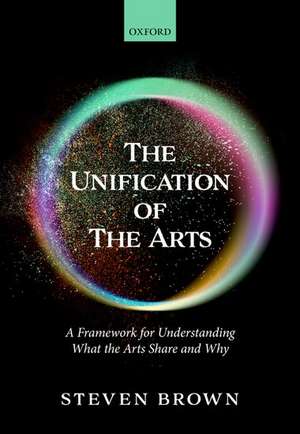The Unification of the Arts: A Framework for Understanding What the Arts Share and Why
Autor Steve N. Brownen Limba Engleză Hardback – 25 noi 2021
Preț: 361.52 lei
Preț vechi: 456.37 lei
-21% Nou
Puncte Express: 542
Preț estimativ în valută:
69.19€ • 71.96$ • 57.12£
69.19€ • 71.96$ • 57.12£
Carte disponibilă
Livrare economică 14-20 martie
Preluare comenzi: 021 569.72.76
Specificații
ISBN-13: 9780198864875
ISBN-10: 0198864876
Pagini: 400
Dimensiuni: 177 x 254 x 27 mm
Greutate: 0.97 kg
Editura: OUP OXFORD
Colecția OUP Oxford
Locul publicării:Oxford, United Kingdom
ISBN-10: 0198864876
Pagini: 400
Dimensiuni: 177 x 254 x 27 mm
Greutate: 0.97 kg
Editura: OUP OXFORD
Colecția OUP Oxford
Locul publicării:Oxford, United Kingdom
Recenzii
The Unification of the Arts is a major contribution to our understanding of the origin and nature of the arts. Brown's argument is tremendously insightful and tenaciously consistent, though some readers may disagree with some of his core assumptions or assertions, such as a direct adaptive value of the arts, the possibility of group selection, the overwhelming importance of cultural influences, and a downplaying of individual-level competition and achievement in the arts.
The Unification of the Arts demarcates a valuable perspective on some of the most meaningful and rewarding aspects of human experience, and I am keen to see how it will shape our ongoing understanding of them.
The Unification of the Arts is a major contribution to our understanding of the origin and nature of the arts. Brown's argument is tremendously insightful and tenaciously consistent.
The major strength of this book, however, is the broadening of scope and also its interdisciplinary approach...This is quite refreshing. Besides, the book also provides a lot of historical and philosophical digressions, such as Plato's distinction between modes of storytelling that are acted out (mimesis) or narrated (diegesis), Aristotle's concept of imitation and catharsis, Diderotâs definition of acting theory, Baumgarten's view on aesthetics, Rameauâs harmonicity theory on the origins of scales, and Rousseau's conception of the joint origin of music and language. The multiple illuminating figures and tables with classification schemes are also quite refreshing and inspiring.
The Unification of the Arts is a thought-provoking study that will be a welcome challenge to many readers more familiar with traditional debates on art and aesthetics.
It is one thing to study different art forms from a cognitive perspective: it is another to bring together these different lines of research into a unified conceptual framework. This is what Brown aims to do in his ambitious and important book The unification of the arts: A framework for understanding what the arts share and why....Brown has done what few modern cognitive scientists are equipped to do, because most of us specialize in one specific domain (e.g., music psychology) by choice or necessity...Brown's book deserves a wide audi- ence among researchers in cognitive science, the arts, and philosophy, and will be a valuable resource for scholars and students for many years to come.
The Unification of the Arts demarcates a valuable perspective on some of the most meaningful and rewarding aspects of human experience, and I am keen to see how it will shape our ongoing understanding of them.
The Unification of the Arts is a major contribution to our understanding of the origin and nature of the arts. Brown's argument is tremendously insightful and tenaciously consistent.
The major strength of this book, however, is the broadening of scope and also its interdisciplinary approach...This is quite refreshing. Besides, the book also provides a lot of historical and philosophical digressions, such as Plato's distinction between modes of storytelling that are acted out (mimesis) or narrated (diegesis), Aristotle's concept of imitation and catharsis, Diderotâs definition of acting theory, Baumgarten's view on aesthetics, Rameauâs harmonicity theory on the origins of scales, and Rousseau's conception of the joint origin of music and language. The multiple illuminating figures and tables with classification schemes are also quite refreshing and inspiring.
The Unification of the Arts is a thought-provoking study that will be a welcome challenge to many readers more familiar with traditional debates on art and aesthetics.
It is one thing to study different art forms from a cognitive perspective: it is another to bring together these different lines of research into a unified conceptual framework. This is what Brown aims to do in his ambitious and important book The unification of the arts: A framework for understanding what the arts share and why....Brown has done what few modern cognitive scientists are equipped to do, because most of us specialize in one specific domain (e.g., music psychology) by choice or necessity...Brown's book deserves a wide audi- ence among researchers in cognitive science, the arts, and philosophy, and will be a valuable resource for scholars and students for many years to come.
Notă biografică
Steven Brown is Director of the NeuroArts Lab in the Department of Psychology, Neuroscience & Behaviour at McMaster University in Canada. He obtained his Ph.D. in the Department of Genetics and Development at Columbia University in New York, and did postdoctoral research at the Pasteur Institute in Paris, Karolinska Institutet in Stockholm, the University of Texas Health Science Center in San Antonio, and Simon Fraser University in Vancouver. His research deals with the neural and evolutionary bases of the arts. He is co-editor of two books: The Origins of Music (MIT Press) and Music and Manipulation (Berghahn Books).
